
Mauritania, a country in the western region of the continent of Africa, is generally flat, its 1,030,700 square kilometres forming vast, arid plains broken by occasional ridges and clifflike outcroppings. Mauritania is the world’s largest country lying entirely below an altitude of 1,000 metres (3,300 ft). It borders the North Atlantic Ocean, between Senegal and Western Sahara, Mali and Algeria. It is considered part of both the Sahel and the Maghreb. A series of scarps face southwest, longitudinally bisecting these plains in the center of the country. The scarps also separate a series of sandstone plateaus, the highest of which is the Adrar Plateau, reaching an elevation of 500 metres or 1,640 feet. Spring-fed oases lie at the foot of some of the scarps. Isolated peaks, often rich in minerals, rise above the plateaus; the smaller peaks are called Guelbs and the larger ones Kedias. The concentric Guelb er Richat is a prominent feature of the north-central region. Kediet ej Jill, near the city of Zouîrât, has an elevation of 915 metres or 3,002 feet and is the highest peak.
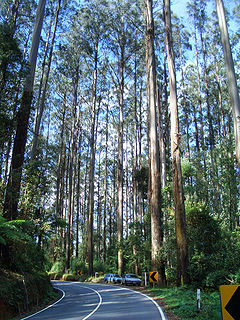
Eucalyptus regnans, known variously as mountain ash, swamp gum, or stringy gum, is a species of medium-sized to very tall forest tree that is native to the Australia states of Tasmania and Victoria. It is a straight-trunked tree with smooth grey bark, but with a stocking of rough brown bark at the base, glossy green, lance-shaped to curved adult leaves, flower buds in groups of between nine and fifteen, white flowers and cup-shaped or conical fruit. It is the tallest of all flowering plants; the tallest measured living specimen, named Centurion, stands 100.5 metres tall in Tasmania.

The mosque swallow is a large swallow. It is a resident breeder in much of sub-Saharan Africa, although most common in the west. It does not migrate but follows the rains to some extent.
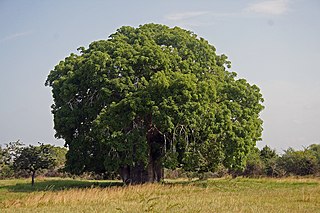
Adansonia is a genus made up of eight species of medium to large deciduous trees known as baobabs. They are placed in the Malvaceae family, subfamily Bombacoideae. They are native to Madagascar, mainland Africa, SW Asia and Australia. Trees have also been introduced to other regions such as Asia. The generic name honours Michel Adanson, the French naturalist and explorer who described Adansonia digitata. The baobab is also known as the "upside down tree", a name that originates from several myths. They are among the most long-lived of vascular plants and have large flowers that are reproductive for a maximum of 15 hours. The flowers open around dusk; opening so quickly that movement can be detected by the naked eye and are faded by the next morning. The fruits are large, oval to round and berry-like and hold kidney-shaped seeds in a dry, pulpy matrix.

Adansonia gregorii, commonly known as the boab, is a tree in the family Malvaceae. As with other baobabs, it is easily recognised by the swollen base of its trunk, which forms a massive caudex, giving the tree a bottle-like appearance. Endemic to Australia, boab occurs in the Kimberley region of Western Australia, and east into the Northern Territory. It is the only baobab to occur in Australia, the others being native to Madagascar and mainland Africa and the Arabian Peninsula . Boab ranges from 5 to 15 metres in height, usually between 9 and 12 metres, with a broad bottle-shaped trunk. Its trunk base may be extremely large; trunks with a diameter of over five metres have been recorded. A. gregorii is deciduous, losing its leaves during the dry winter period and producing new leaves and large white flowers between December and May. Boabs are pollinated by the convolvulus hawk-moth Agrius convolvuli.
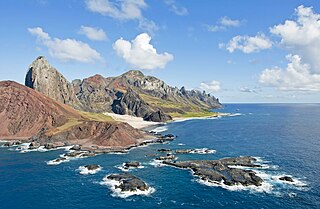
Trindade and Martim Vaz is an archipelago located in the South Atlantic Ocean about 1,100 kilometres east of the coast of the Brazilian state of Espírito Santo, of which it forms a part. The archipelago has a total area of 10.4 square kilometres and a navy supported research station of up to 8 persons.The archipelago consists of five islands and several rocks and stacks; Trindade is the largest island, with an area of 10.1 square kilometres ; about 49 kilometres east of it are the tiny Martim Vaz islets, with a total area of 0.3 square kilometres.

Adansonia digitata, the African baobab, is the most widespread tree species of the genus Adansonia, the baobabs, and is native to the African continent and the southern Arabian Peninsula. These are long-lived pachycauls; radiocarbon dating has shown some individuals to be over 2,000 years old. They are typically found in dry, hot savannas of sub-Saharan Africa, where they dominate the landscape and reveal the presence of a watercourse from afar. They have traditionally been valued as sources of food, water, health remedies or places of shelter and are a key food source for many animals. They are steeped in legend and superstition. In recent years, many of the largest, oldest trees have died, possibly due to climate change. Common names for the baobab include monkey-bread tree, upside-down tree, and cream of tartar tree.

The wildlife of Botswana refers to the flora and fauna of this country. Botswana is around 90% covered in savanna, varying from shrub savanna in the southwest in the dry areas to tree savanna consisting of trees and grass in the wetter areas. Even under the hot conditions of the Kalahari Desert, many different species survive; in fact the country has more than 2500 species of plants and 650 species of trees. Vegetation and its wild fruits are also extremely important to rural populations living in the desert and are the principal source of food, fuel and medicine for many inhabitants.

Pachycauls are plants with a disproportionately thick trunk for their height, and few branches. This can be the product of exceptional primary growth or disproportioate secondary growth as with Adansonia. The word is derived from the Greek pachy- meaning thick or stout, and Latin caulis meaning the stem. All of the tree species of cactus are pachycauls, as are most palms, Cycads and pandans. The most extreme pachycauls are the floodplains, or riverbottom variety of the African Palmyra with primary growth up to seven feet in thickness, and the Coquito Palm with primary growth up to six feet thick. The most pachycaulous cycad is Cycas thouarsii at up to five feet in diameter. The tallest pachycaul is the Andean Wax Palm at up to 220 feet. and about 16 inches (41 cm) in diameter. The most pachycaulous cactus is the Bisnaga with primary growth up to 4 ft 4 in in diameter. The largest caudex type pachycaul is the African Baobab. One called the Glencoe Tree at Hoedspruit, South Africa has a basal diameter of 52 ft 2 in. This tree suffered a severe trauma and is dying.

Adansonia grandidieri is the biggest and most famous of Madagascar's six species of baobabs. It is sometimes known as Grandidier's baobab or giant baobab. In French it is called Baobab malgache. The local name is renala or reniala. This tree is endemic to the island of Madagascar, where it is an endangered species threatened by the encroachment of agricultural land. This is the tree found at the Avenue of the Baobabs.
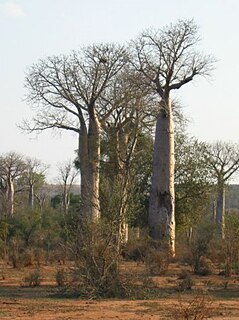
Adansonia za is a species of baobab in the genus Adansonia of the family Malvaceae. It was originally named in French as anadzahé. Common names in Malagasy include bojy, boringy, bozy, bozybe, ringy, and za, the last of which gives the plant its specific epithet. Eight Adansonia species are recognized, with six endemic to Madagascar. Adansonia za is the most widespread of the Madagascar endemics.
M'Clure Bay is a Peel Sound waterway in Qikiqtaaluk Region, Nunavut, Canada. It is located on the western side of Somerset Island, between Aston Bay and Birmingham Bay.
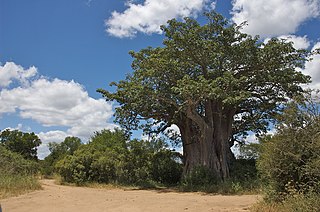
Glencoe Baobab is the stoutest and second largest baobab in South Africa, and possibly the stoutest tree in the world. The tree is located in Glencoe Farm, near Hoedspruit, Limpopo Province and had a trunk diameter of 15.9 m (52 ft).

Sunland Baobab is a well-known enormous baobab in Southern Africa. The tree is located on Sunland Farm, near Modjadjiskloof, Limpopo Province. In one study the tree was carbon-dated and found to be an estimated 1,060 years old, plus or minus 75 years. Results of other studies have however suggested much higher ages. The tree bloomed profusely in spring and provided a refuge to two pairs of owls, and other bird species. Most of the tree died in 2016 and 2017.
Mungbere is a small town in Haut-Uele province, in the north of the Democratic Republic of Congo.
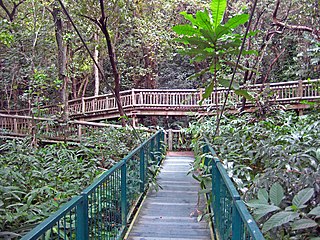
The Lowveld National Botanical Garden, one of the nine National Botanical Gardens of South Africa is located just outside Mbombela, Mpumalanga at the confluence of the Crocodile River and Nels River, which are separated by an extensive promontory. A lookout point at the far end of the garden, reached through a rainforest trail allows views of the river in the deep gorge. The N4 road runs through the northern portion of the park.
Tree girth measurement is one of the most ancient, quickest, and simplest of foresters' measures of size and records of growth of living and standing trees. The methods and equipment have been standardized differently in different countries. A popular use of this measurement is to compare outstanding individual trees from different locations or of different species.

Ceriops tagal, commonly known as spurred mangrove or Indian mangrove, is a mangrove tree species in the family Rhizophoraceae. It is a protected tree in South Africa. The specific epithet tagal is a plant name from the Tagalog language.

The Otzumer Balje is a gat in the North Sea.
















